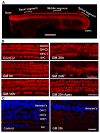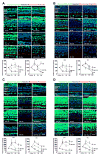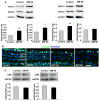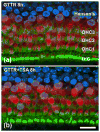Aminoglycoside-induced histone deacetylation and hair cell death in the mouse cochlea
- PMID: 19141081
- PMCID: PMC3341988
- DOI: 10.1111/j.1471-4159.2009.05871.x
Aminoglycoside-induced histone deacetylation and hair cell death in the mouse cochlea
Abstract
Post-translational modification of histones is an important form of chromatin regulation impacting transcriptional activation. Histone acetyltransferases, for example, acetylate lysine residues on histone tails thereby enhancing gene transcription, while histone deacetylases (HDACs) remove those acetyl groups and repress gene transcription. Deficient histone acetylation is associated with pathologies, and histone deacetylase inhibitors have been studied in the treatment of cancer and neurodegenerative diseases. Here we explore histone acetylation in cochlear sensory cells following a challenge with gentamicin, an aminoglycoside antibiotic known to cause loss of auditory hair cells and hearing. The addition of the drug to organotypic cultures of the mouse organ of Corti decreased the acetylation of histone core proteins (H2A Ack5, H2B Ack12, H3 Ack9, and H4 Ack8) followed by a loss of sensory cells. Protein levels of HDAC1, HDAC3 and HDAC4 were increased while the histone acetyltransferases such as CREB-binding protein and p300 remained unchanged. We next hypothesized that protecting histone acetylation should prevent cell death and tested the effects of HDAC-inhibitors on the actions of gentamicin. Co-treatment with trichostatin A maintained near-normal levels of acetylation of histone core proteins in cochlear hair cells and attenuated gentamicin-induced cell death. The addition of sodium butyrate also rescued hair cells from damage by gentamicin. The results are consistent with an involvement of deficient histone acetylation in aminoglycoside-induced hair cell death and point to the potential value of HDAC-inhibitors in protection from the side effects of these drugs.
Conflict of interest statement
There are no conflicts of interest for any of the authors.
The data contained in the manuscript have not been previously published, have not been submitted elsewhere, and will not be submitted elsewhere while under review.
All experimental protocols were approved by the University of Michigan Committee on Use and Care of Animals and animal care was supervised by the University of Michigan’s Unit for Laboratory Animal Medicine.
All authors have reviewed the contents of the manuscript, approve of its contents, and validate the accuracy of the data.
Figures






References
-
- Bhaumik SR, Smith E, Shilatifard A. Covalent modifications of histones during development and disease pathogenesis. Nat Struct Mol Biol. 2007;14:1008–1016. - PubMed
-
- Ding D, Stracher A, Salvi RJ. Leupeptin protects cochlear and vestibular hair cells from gentamicin ototoxicity. Hear Res. 2002;164:115–126. - PubMed
Publication types
MeSH terms
Substances
Grants and funding
LinkOut - more resources
Full Text Sources
Other Literature Sources
Miscellaneous

